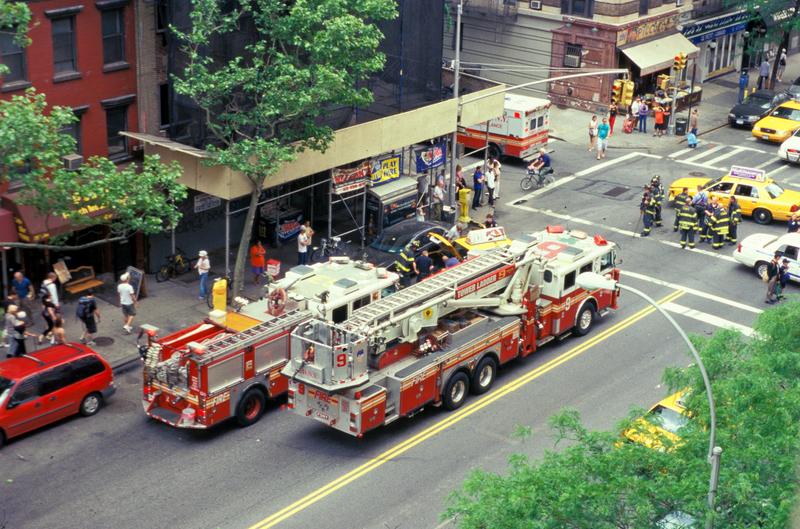Alison Stewart: This is All Of It on WNYC. I'm Alison Stewart. Earlier this week at our April Get Lit with All Of It book club event, we spoke to author Leila Lalami about her new novel, The Dream Hotel, and we heard a special live performance from Imal Gnawa. It was a great time. On tomorrow's show, we'll play excerpts from that conversations, and because May, it's time to start reading this month's book club pick, it's Audition by Katie Kitamura.
We'll be discussing the book on Thursday, May 29th, at the library. Tickets are free, but they tend to go fast, so get yours now by heading to wnyc.org/getlit. Again, that's wnyc.org/getlit.
That's in the future, but let's get this hour started with one of the defining sounds in New York. Fire trucks and ambulances often use lights and sirens when responding to an emergency call. The idea is to clear traffic and provide care as fast as possible. It's called running hot. Ben Naddaff-Hafrey is a senior producer for Pushkin Industries. He lives in Brooklyn and across the street from a fire station. You know what that means.
Ben decided to look into why sirens are so loud in the first place and whether they actually save time during an emergency. He reported on what he discovered for a recent episode of the Revisionist History podcast and found out a whole bunch of things, including that siren usage in New York City has never really been studied. The episode is called Running Hot. Ben is with me now to discuss what he found. Welcome back to the show.
Ben Naddaff-Hafrey: Thanks for having me on.
Alison Stewart: Just by listening to this episode, you are in deep. [chuckles]
Ben Naddaff-Hafrey: Yes. Oh, no, I'm way down the rabbit hole. [laughs] I didn't even know there was such a rabbit hole.
Alison Stewart: Could you describe what you would hear on any night in your house?
Ben Naddaff-Hafrey: It's a mix. There is a really distinctive sound for most fire trucks. It's called the federal Q2B siren, made by Federal Signal. That tends to be what they use. Then there's another sound for ambulance sirens. I would say I hear a healthy mix of both of them. It just always struck me-- When my wife and I moved into this apartment, we were like, "Is this going to be loud?" "No. Surely they don't use the siren all the time." [chuckles]
Alison Stewart: I was going to ask, when you moved in, what were your questions about that?
Ben Naddaff-Hafrey: That was my question. We liked the apartment, and we kind of ignored it. I make podcasts. I'm a musician. I work a lot with my ears, and so it's just the kind of thing that I noticed. I was like, "This seems to be happening an awful lot and maybe an increasing amount, and it's really quite loud." Then I started looking into how loud and why it's so loud. That's what I thought this piece was going to be about, but then it became about something radically different.
Alison Stewart: When did you decide that you were going to research this? There must have been a day.
Ben Naddaff-Hafrey: There were two things. First, I remember I was, just for fun, trying to record something in my house, and I kept getting interrupted by sirens. I was like, "Well, maybe I can just push this later into the evening." I was playing guitar, and I got to the point where it was like 3:00 AM, and I would still have sirens showing up on the recording. I was like, "I guess that's just how it is," but that's sort of striking that, "I know there's no traffic right now. Why is the siren still sounding?"
That was Part 1, but Part 2 was, there's a dog in our neighborhood who howls almost every time the siren goes off. This I found immensely charming, and I was like, "I need to meet this dog and understand why is he howling? How does he feel about the siren?" It's sort of I knew. I was like, maybe that's a way to explore this issue in a story. If I look for the dog, he can be some meaningful part of whatever conclusion I come to after researching this about why the sirens are the way they are.
Alison Stewart: In case people wondered, this is what the dog sounds like.
[dog howls]
[laughter]
Ben Naddaff-Hafrey: It would be like 2:00 AM, and you just hear like [imitates a dog howl] [laughs] It was just so-- He sounded like a werewolf. I was like, "What is this creature?"
Alison Stewart: It's almost like he was making fun of the siren.
Ben Naddaff-Hafrey: Well, yes. Right. Why is he howling? That's what I wanted to understand.
Alison Stewart: You and your wife decided to make a spreadsheet.
Ben Naddaff-Hafrey: Yes.
Alison Stewart: Explain to us the spreadsheet and what you learned from looking at it all laid out in front of you.
Ben Naddaff-Hafrey: Well, I think any good piece of research begins by totally just flailing around haplessly. That was our flailing moment. I felt that in order to find this dog, I needed to first understand if he was on the street north of me or south of me. I was like, well, then we should create a spreadsheet and track every time the siren sounds. When do we hear the dog, and do we hear him from the front of the house or the back of the house?
I thought this was going to help us figure out where exactly he was, and then it turned out that basically you can't distinguish between if it's the front of the house or the back of the house. He's loud enough, you can hear him on both, or maybe more. It's a smaller apartment. This was not particularly useful for those purposes, but we did learn that in a-- It was less than 24 hours, but it was about 24 sirens sounding in the course of the day.
Alison Stewart: Listeners, we want to get you in on this conversation. Maybe you've worked as a first responder. When you get an emergency call, how often are you running hot? Do you think the siren makes your response faster or more effective, or do you think there's a future where sirens can be used more strategically? Our number is 212-433-WNYC, 212-433-9692.
Maybe you live near a fire station or a hospital or a police precinct, and you hear sirens. How loud is the volume of the siren? How will it affect you when you pass it on the street, when you're in your living room, when you're living your life? Give us a call. 212-433-9692, 212-433-WNYC. My guest is Ben Naddaff-Henfrey. Sorry, you warned me.
Ben Naddaff-Hafrey: It's a hard one.
[laughter]
Alison Stewart: Ben Naddaff-Hafrey, senior producer for Pushkin Industries. We're talking about a new episode. Ben reported for the podcast Revisionist History. It's called Running Hot. Ben looked into why emergency vehicles' sirens are so loud. Can we do a little who, what, where, when, why of sirens?
Ben Naddaff-Hafrey: Absolutely.
Alison Stewart: When did they become part of emergency equipment?
Ben Naddaff-Hafrey: The siren is-- This is part of what's so interesting. It is effectively ancient technology. We had sirens before we had ambulances, modern EMS, and paramedic services. This is an old thing. I think that's part of where this argument goes is we have this outdated notion of how this works that we continue to apply, even though it doesn't really work the way we think it does.
New York actually had some of the first ambulances in the country in the 19th century. They were horse-drawn, obviously spring-loaded to cushion the transport of the patient, but the siren equivalent they had was drivers shouting and then operating a gong with their right foot. This was like pre-electromechanical sirens, but those came pretty early in the 20th century.
Especially once we transferred over to motorized vehicles, you can see a video of the equivalent of a fire truck then responding to scenes with bells ringing and sirens sounding from the 1920s. It's been around for a while, but obviously, it really took off after EMS became a real thing in this country.
Alison Stewart: This might sound like an obvious question, but I'm going to ask it anyway. What is the working theory about why sirens are effective?
Ben Naddaff-Hafrey: Yes, it's so obvious that it is not a question that I asked when I started this. I was just like, "Do they need to be so loud?" Then I was like, "Wait a minute, do they make any sense at all?" Kind of. The theory is that you have a mission, you have to get to someone as quickly as possible, but between you and that person, there's quite a lot of traffic, and especially in New York City.
What you do with the siren is it alerts the people ahead of you, who might not be looking in the rearview mirror to see your lights, that you are coming. It needs to be an easy-to-localize sound. There's some question of whether or not the siren we have is so easy to localize, but it tells you that an ambulance is coming and needs you to clear the way. It also notifies you they're going to be breaking traffic laws.
Also, because it's so loud, you hear it from far away. It can theoretically alert people at the next intersection, "Be careful because someone's going to be blowing through this intersection shortly." That is the function of the siren. It's to do all those things because there's this assumption that every 911 call needs to be addressed immediately.
Alison Stewart: I have to ask you to hold because we have just learned that the new Pope is an American.
Ben Naddaff-Hafrey: Wow.
Alison Stewart: He is from Chicago. We are now going to go to NPR's special coverage.

